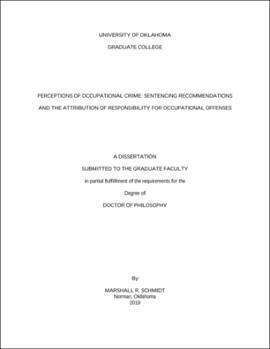| dc.description.abstract | This dissertation examines how offender and case attributes affect criminal perceptions, responsibility attributions, and recommended sentencing outcomes for occupational and organizational crimes. I use affect control theory and attribution theory to derive my predictions. I test predictions using online vignette experiments administered to: community college students in the South, students at a large southern university, and Amazon Mechanical Turk users. First, I examine how an offender’s occupational status, gender, and the word used to describe an offender’s crime affect the recommended monetary fine and recommended prison sentence that participants assign to offenders. Consistent with my affect control theory-derived predictions, I find that occupational status increases recommended punishment, that females are punished more leniently than males, and that offenders described as overcharging clients are recommended a lighter prison sentence but not a lighter monetary fine than offenders who are described as stealing from clients. Second, extending previous research, I examine the independent and mediating effects of negative and potent post-crime impressions of occupational offenders on punishment. As predicted, I find high occupational status increases punishment, and that this effect is mediated by post-crime impressions of offender potency and power. However, contrary to predictions, I find that post-crime impressions of offender negativity and status do not mediate the effect of occupational status on punishment. Lastly, I examine how the social role of offenders and the description of an offender’s offense as either following or departing from standard operating procedures affects attributions of responsibility and the recommended monetary fine that participants assign to offenders. I find support for attribution theory predictions on attributions of causality and coerciveness for both the social role of offenders and standard operating procedures. However, findings on attributions of intentionality for the social role of offenders, and findings on attributions of knowledge for standard operating procedures, are opposite of predictions. I also find that attributions of moral wrongfulness for the social role of offenders and standard operating procedures are contrary to predictions. Consistent with punishment hypotheses, participants recommended greater monetary fines for autonomous offenders and offenders described as offending against standard operating procedures than conformist offenders and those offenders described as offending by following standard operating procedures. In partial support of mediation predictions, I find that causality and coerciveness both mediate the effect of the social role of offenders and standard operating procedures on the recommended monetary fine participants assign to offenders. | en_US |
